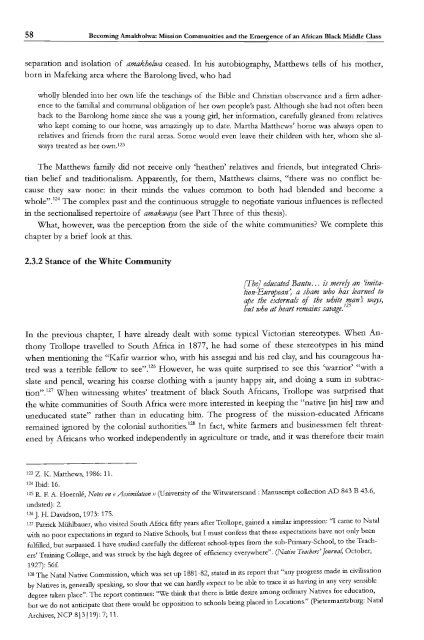South African Choral Music (Amakwaya): Song, Contest and the ...
South African Choral Music (Amakwaya): Song, Contest and the ...
South African Choral Music (Amakwaya): Song, Contest and the ...
You also want an ePaper? Increase the reach of your titles
YUMPU automatically turns print PDFs into web optimized ePapers that Google loves.
58 Becoming Amakholwa: Mission Communities <strong>and</strong> <strong>the</strong> Emergence of an Mrican Black Middle Class<br />
separation <strong>and</strong> isolation of amakholwa ceased. In his autobiography, Mat<strong>the</strong>ws tells of his mo<strong>the</strong>r,<br />
born in Mafeking area where <strong>the</strong> Barolong lived, who had<br />
wholly blended into her own life <strong>the</strong> teachings of <strong>the</strong> Bible <strong>and</strong> Christian observance <strong>and</strong> a firm adherence<br />
to <strong>the</strong> familial <strong>and</strong> communal obligation of her own people's past. Although she had not often been<br />
back to <strong>the</strong> Barolong home since she was a young girl, her information, carefully gleaned from relatives<br />
who kept coming to our home, was amazingly up to date. Martha Mat<strong>the</strong>ws' home was always open to<br />
relatives <strong>and</strong> friends from <strong>the</strong> rural areas. Some would even leave <strong>the</strong>ir children with her, whom she always<br />
treated as her own.t23 The Mat<strong>the</strong>ws family did not receive only 'hea<strong>the</strong>n' relatives <strong>and</strong> friends, but integrated Chris<br />
tian belief <strong>and</strong> traditionalism. Apparently, for <strong>the</strong>m, Mat<strong>the</strong>ws claims, "<strong>the</strong>re was no conflict be<br />
cause <strong>the</strong>y saw none: in <strong>the</strong>ir minds <strong>the</strong> values common to both had blended <strong>and</strong> become a<br />
whole".124 The complex past <strong>and</strong> <strong>the</strong> continuous struggle to negotiate various influences is reflected<br />
in <strong>the</strong> sectionalised repertoire of amakwqya (see Part Three of this <strong>the</strong>sis).<br />
What, however, was <strong>the</strong> perception from <strong>the</strong> side of <strong>the</strong> white communities? We complete this<br />
chapter by a brief look at this.<br />
2.3.2 Stance of <strong>the</strong> White Community<br />
[[he] educated Bantu... zs merelY an 'imitation-European:<br />
a sham who has learned to<br />
e <strong>the</strong> externals of <strong>the</strong> white mans wqys,<br />
,l. h . 125<br />
ut WfJO at ear! remazns savage.<br />
In <strong>the</strong> previous chapter, I have already dealt with some typical Victorian stereotypes. When An<br />
thony Trollope travelled to <strong>South</strong> Africa in 1877, he had some of <strong>the</strong>se stereotypes in his mind<br />
when mentioning <strong>the</strong> "Kafir warrior who, with his assegai <strong>and</strong> his red clay, <strong>and</strong> his courageous ha<br />
tred was a terrible fellow to see".126 However, he was quite surprised to see this 'warrior' "with a<br />
slate <strong>and</strong> pencil, wearing his coarse clothing with a jaunty happy air, <strong>and</strong> doing a sum in subtraction".127<br />
When witnessing whites' treatment of black <strong>South</strong> <strong>African</strong>s, Trollope was surprised that<br />
<strong>the</strong> white communities of <strong>South</strong> Africa were more interested in keeping <strong>the</strong> "native [in his] raw <strong>and</strong><br />
uneducated state" ra<strong>the</strong>r than in educating him. The progress of <strong>the</strong> mission-educated <strong>African</strong>s<br />
remained ignored by <strong>the</strong> colonial authorities. l28 In fact, white farmers <strong>and</strong> businessmen felt threat<br />
ened by <strong>African</strong>s who worked independently in agriculture or trade, <strong>and</strong> it was <strong>the</strong>refore <strong>the</strong>ir main<br />
123 Z. K. Mat<strong>the</strong>ws, 1986: 11.<br />
124 Ibid: 16.<br />
125 R. F. A. Hoernle, Notes on «Assimilation )) (University of <strong>the</strong> Witwatersr<strong>and</strong> : Manuscript collection AD 843 B 43.6,<br />
undated): 2.<br />
126 J. H. Davidson, 1973: 175.<br />
127 Patrick Miihlbauer, who visited <strong>South</strong> Africa fifty years after Trollope, gained a similar impression: ''1 came to Natal<br />
with no poor expectations in regard to Native Schools, but I must confess that <strong>the</strong>se expectations have not only been<br />
fulfilled, but surpassed. I have studied carefully <strong>the</strong> different school-types from <strong>the</strong> sub-PriIDary-School, to <strong>the</strong> Teachers'<br />
Training College, <strong>and</strong> was struck by <strong>the</strong> high degree of efficiency everywhere". (Native Teachers' Journal, October,<br />
1927): 56£<br />
128 The Natal Native Commission, which was set up 1881-82, stated in its report that "any progress made in civilisation<br />
by Natives is, generally speaking, so slow that we can hardly expect to be able to trace it as having in any very sensible<br />
degree taken place". The report continues: ''We think that <strong>the</strong>re is little desire among ordinary Natives for education,<br />
but we do not anticipate that <strong>the</strong>re would be opposition to schools being placed in Locations." (pietermaritzburg: Natal<br />
Archives, NCP 813119): 7; 11.<br />
ru

















